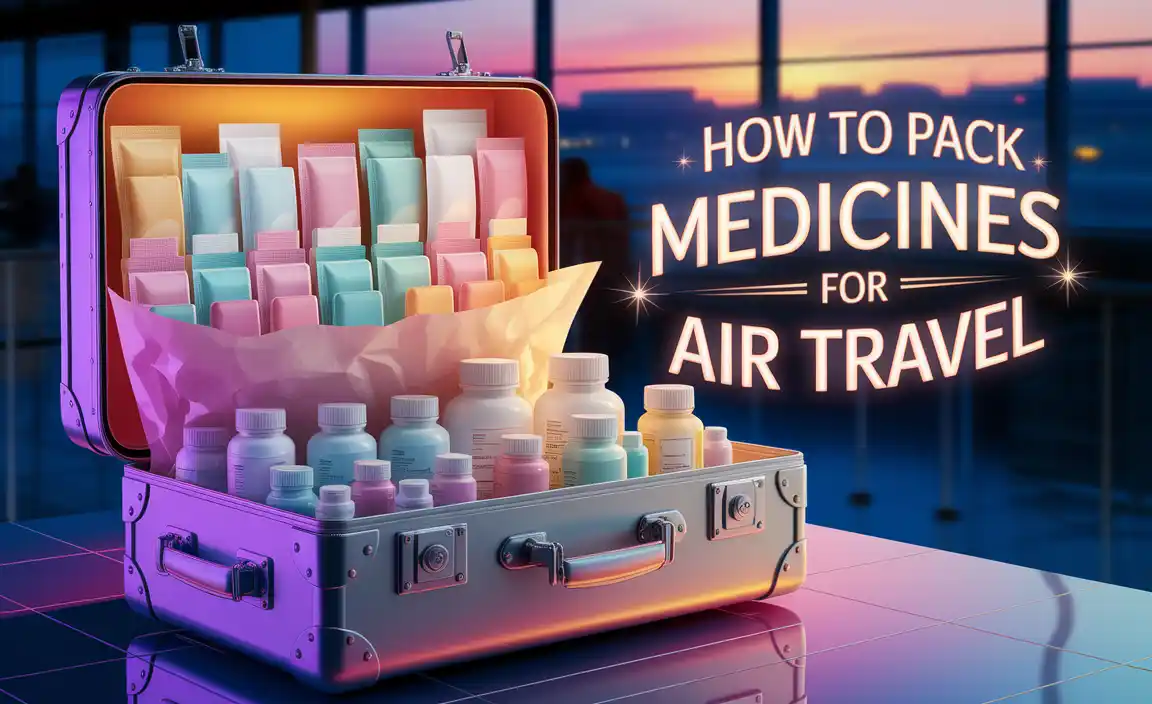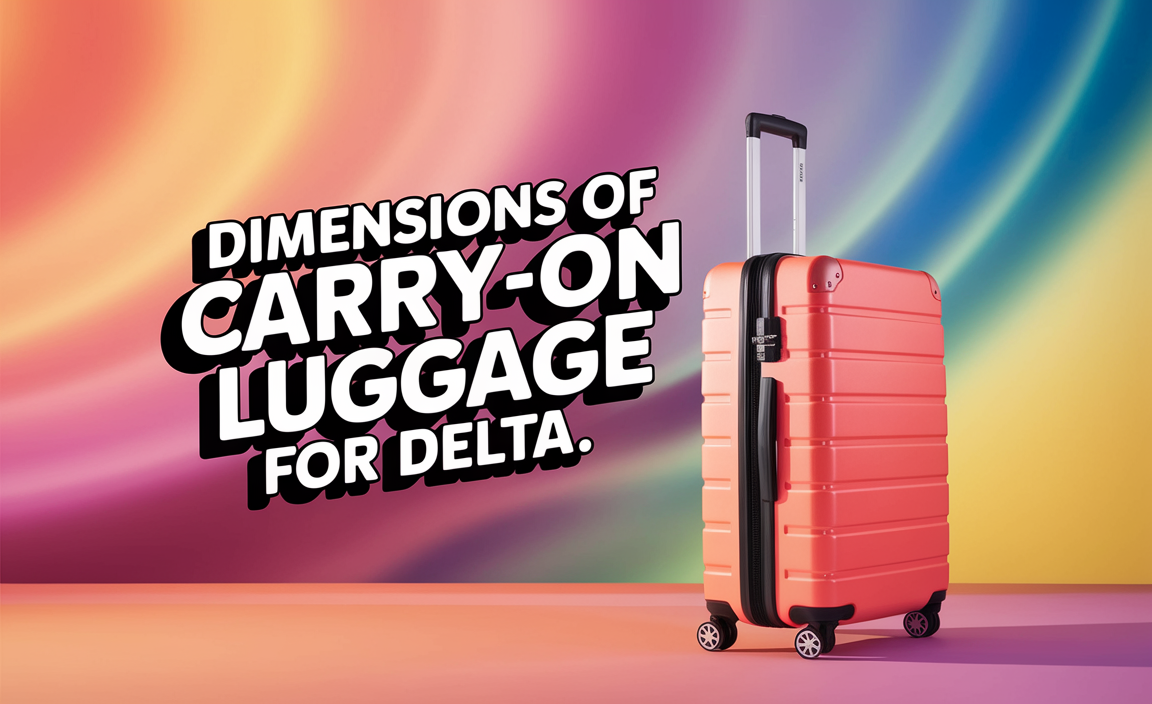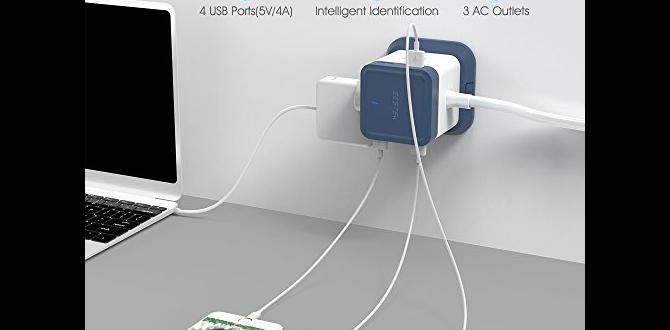Imagine you’re getting ready for a fun vacation with your family. You’ve packed your favorite clothes, toys, and games. But what about your medicines?
Did you know that packing medicines for air travel can be as tricky as solving a puzzle? Some medicines are liquids, others are pills, and you need to keep them safe. Have you ever wondered why there are rules for taking medicine on a plane?
These rules help keep everyone safe and healthy while flying. So, how can you make sure you pack your medicines just right? It’s easier than you might think! Let’s find out how to pack medicines for air travel smartly and safely.

How To Pack Medicines For Air Travel Safely
Packing medicines for air travel might seem tricky, but it’s simple with a plan. Picture this: your medication keeps you going every day. Remember to pack them in your carry-on bag. This way, they stay with you even if your luggage gets lost. Use clear, labeled bags for pills and liquids. Keep a list of your medications in case you need a doctor’s help on your journey. Isn’t it comforting to know you’re prepared?
Understanding Airline Regulations for Carrying Medicines
Essential airline policies and rules for medications. Required documentation for prescription and overthecounter drugs.
Flying with medicines needs care. Airlines have rules for carrying medications. These rules keep everyone safe. Do you know what documents to bring? For prescription medicines, carry a doctor’s note or a prescription label. It must match your name. For over-the-counter drugs, pack them in original packaging.
- Keep medicines in your carry-on bag.
- Inform security staff promptly.
- Have a copy of your prescription. It helps if you lose medicines or need refills abroad.
Did you know some airlines allow medicines as extra carry-ons? Always check with your airline before traveling. This keeps your trip smooth and happy. Safe travels!
Organizing Your Medications: Best Practices
Categorizing and labeling your medications. Tips for creating an organized medication travel kit.
Before you head to the airport, create a mini-pharmacy that would make your doctor proud! Sort your medications by type, like sorting candies by color—because no one wants to pop a vitamin when they meant to take a painkiller. Label each pill bottle or packet clearly, so you’re not guessing later! Get a compact travel kit and line up your medications as neatly as a parade. Here’s an example of how you can organize:
| Medication Name | Dosage | Time |
|---|---|---|
| Cough Syrup | 10ml | Morning |
| Pain Relief | 500mg | Evening |
Storing your medicines in zip-lock bags or separate pill organizers keeps things tidy and TSA-friendly. A smart tip: keep a list of your medications on your phone or paper, because as the old saying goes, “Better safe than sorry!” It’s always handy to have a backup, like a spare cape for a superhero. Safe travels and happy pill sorting!
Packaging Medications for Safety and Accessibility
Recommended packaging materials and containers. Ensuring easy access during travel.
When packing medications for a trip, using clear, zip-lock bags can be helpful. These keep pills safe from spills. Small containers or pill organizers help keep everything in its place. Store liquids under 3.4 ounces in secure bottles. Keep your medicine near the top of your bag. This makes it easy to grab during travel. Always pack a copy of any prescriptions you need. This way, you’re prepared if you must show them at the airport.
What is the best way to pack medications for a flight?
Place medications in your carry-on luggage for easy access and security. Use labeled containers or travel bottles to prevent spills, and ensure all liquids are in a transparent, resealable bag. Keeping them within reach helps if you need them in-flight. Additionally, check airline guidelines to confirm you meet any specific requirements for carrying medications.
Managing Liquids and Gels According to TSA Guidelines
Rules for liquid and gel medications in carryon baggage. Strategies for packing liquid medicines within TSA limits.
Flying with medications has some rules. If you have liquid or gel medicines in your carry-on, keep them under 3.4 ounces per the TSA guidelines. They should all fit together in a clear, quart-sized bag. Imagine your pills having a cozy sleepover and this bag is their hotel room! A small tip: place them on top of your bag for easy access during screening.
Here’s a simple guide:
| Type | TSA Limit |
|---|---|
| Liquid Medicine | 3.4 ounces |
| Gel Medicine | 3.4 ounces |
Wondering if special exceptions exist? Indeed, they do! For certain medications, you may be allowed more than 3.4 ounces. Just let the TSA officer know. Bonus tip: Label your medicine bottles in case Dorothy from TSA wants to read them. Keep your medicines with you, not in checked luggage, as it might take its own vacation.
Customs Declarations and International Travel Considerations
How to declare medicines at customs efficiently. Special considerations for traveling with medicines internationally.
When flying internationally with medicines, customs can be as tricky as a level boss in a video game. First, keep your meds in their original containers; it’s medicine’s passport through customs. So, when the customs officer asks, “What’s all this?”, you can show them your tiny traveling pharmacy without worry.
Consider the rules of the country you’re entering. Some meds are as welcome as cats at a dog party. Double-check if you need special permits or documents. Here’s a little guide to help:
| Item | Action |
|---|---|
| Label your meds | Keep in original packaging |
| Documentation | Get a doctor’s note for prescriptions |
| Country regulations | Check legality and requirements |
Remember, informing customs upfront saves time and avoids hassles. As travel expert Rick Steves says, “When in doubt, simplify!” If you’re traveling with extra-sensitive meds, consult both your doctor and airline. They’re like the wise old owls of travel, full of wisdom. So, pack wisely, declare confidently, and travel smoothly!
Storing Medications During Long Flights
Temperature control measures on flights. Ensuring medication efficacy while in transit.
Keeping your medicines safe on a long flight is important. Airplanes can get very cold. To keep medication efficacy, use a special bag called a thermal pouch. This bag helps control the temperature.
- Leave the medicine in its original packaging.
- Use a cool gel pack if needed, but avoid dry ice.
Remember, always keep your medicines in your carry-on bag so they don’t get lost.
How can I keep medication safe during a flight?
Keep medicines cool and within reach. Thermal pouches and gel packs help. Use them to maintain proper temperature control. Always pack them in your carry-on. This way, they stay safe, even when the cabin gets cold. Always talk to your doctor if you’re unsure about your medication needs on a flight. Airlines often allow bringing medications on board if they are properly packed.
Addressing Special Needs and Emergency Preparations
Preparing for medication emergencies or contingencies. Tips for travelers with specific medical requirements.
Traveling with medications requires special care. Be ready for emergencies. Have a list of your drugs. Carry extra doses in case of delays. Use a travel pill organizer. Keep medicine in its original packaging. Inform airlines of any special needs. For example, if you need injectable medicine, let the staff know.
What should you do for sudden sicknesses during air travel?
Stay calm and informed. Know the airline’s medical help options. Always have a basic first-aid kit. Include items like band-aids, antiseptic wipes, and pain relievers. Ask the flight crew for help if needed.
Is it necessary to bring a doctor’s note for medical needs?
Yes, it helps. A note explains your medication and dosage. This is important for security checks and emergencies. Having it translated in the local language of your destination is also smart.
- Keep meds in a clear, zip-lock bag.
- Always follow the TSA rules.
- Contact the airline for any rules about medicine.
- Double-check prescription labels.
- Pack medication in your carry-on bag.
Frequently Asked Questions About Traveling With Medicines
Common concerns and expert solutions. Clarifications on misunderstood policies or practices.
Traveling with medicines can feel like solving a puzzle, but it’s easier than it seems. Many people worry about carrying pills onboard. Here’s a hint: you can keep them in your carry-on. Do you need prescriptions? Yes, you do! Bring them along to avoid airport dramas. Have you heard that liquids over 100ml can be tricky? Not if they’re for medicines!
Policies can be confusing, but it helps to check with your airline. Here are some common concerns and solutions:
| Concern | Solution |
|---|---|
| Prescription Needed? | Yes, pack a copy with you. |
| Liquid Rules | Inform security if essential. |
Security staff usually understand, so no need to worry. Remember, being prepared keeps you stress-free! Happy flying!
Conclusion
When packing medicines for air travel, remember to use original containers and keep them in your carry-on. Always bring a doctor’s note for prescriptions. Double-check airline rules to avoid surprises. We recommend creating a medicine checklist to stay organized. For more tips, explore travel blogs or guides. Safe travels!
FAQs
What Are The Regulations For Carrying Prescription Medications In Carry-On Luggage During Air Travel?
When you fly on a plane, you can carry your prescription medicine with you in your bag. Make sure your medicine is in its original bottle with your name on it. It’s good to bring a note from your doctor too. You should show your medicine to the security people if they ask. Keep all your medicine together so it’s easy to find.
How Should Liquid Medications Be Packed To Comply With Airline Security Guidelines?
When you pack liquid medicine for a flight, use small containers that hold up to 3.4 ounces (100 milliliters). Place these containers in a clear plastic bag that seals at the top, like a zipper bag. Keep this bag handy so you can show it at security checks. If you have more medicine than this, tell the airport staff.
Are There Any Specific Labeling Requirements For Medications When Flying Internationally?
Yes, there are specific requirements. You should keep your medicine in its original bottle with labels. The label usually includes your name and the doctor’s information. This helps airport staff understand your medicine is safe and needed. Always carry a copy of your doctor’s note just in case.
What Precautions Should Be Taken To Ensure The Safe Packing Of Temperature-Sensitive Medications For Air Travel?
To pack medicines that don’t like hot or cold weather, use a small cooler bag. Put ice packs in the bag to keep medicine cool. Wrap medicines in bubble wrap to keep them safe. Double-check with a grown-up to make sure the bag stays closed and doesn’t spill. Always keep the medicine with you, not in the checked luggage.
How Can Travelers Manage Time Zone Changes When Scheduling Doses For Chronic Medication During A Flight?
Travelers can keep taking their medicine on the same schedule by using a watch or timer. Change your watch to the new time zone when you get on the plane. If you need help, ask an adult or a doctor before you fly. Always pack your medicine in your carry-on bag, so it’s easy to reach.








